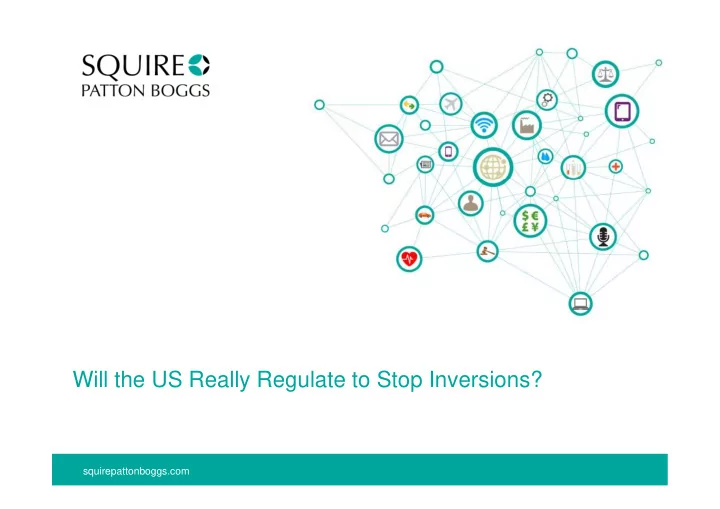

Will the US Really Regulate to Stop Inversions? squirepattonboggs.com
What is a Corporate Inversion? In a corporate “inversion”, a US company acquires a non-US company and, while so doing, relocates its parent company to a non-US jurisdiction, but the enterprise continues to be largely managed and controlled from the US. In 2014, there has been a “wave” of inversion announcements and both Congress and the Obama Administration have expressed concern about the impact these transactions could have on the US economy in general and the US tax base in particular and questioned whether existing anti-inversion legislation is adequate. While anti-inversion legislation has been proposed (in some cases with retroactive effect), Congress did not take legislative action to curb inversions before adjourning for the November midterm elections. However, the release of US Treasury’s notice that it intends to issue anti-inversion regulations appears to have resulted in one or more inversion transactions being abandoned or restructured. The US Treasury may take further action in the near future. squirepattonboggs.com 2
Principal Types of Inversion Legislative Proposals New requirements for a “valid” inversion: Increase the required percentage of legacy shareholders of the foreign enterprise from >20 percent to >50 percent. Require the combined enterprise to be “managed and controlled” from outside the US. Limit “earnings stripping” transactions in which intercompany debt is used to reduce the post-inversion US tax on income from operations within the US. Impose penalties on US companies that invert: Impose an “exit tax” on non-US earnings that have not previously been taxed by the US. Prohibit the awarding of federal contracts to inverted companies. squirepattonboggs.com 3
Guidance from the US Department of the Treasury On September 22, 2014, the US Treasury and IRS issued Notice 2014-52 to announce that regulations would later be issued to address inversion transactions that are structured to avoid the “purposes” of existing US tax laws, and would be retroactive to transactions completed after September 22, 2014. The principal provisions of the forthcoming regulations will: For a period of 10 years following an inversion: • Prevent inverted companies from accessing the US parent’s non-US subsidiaries (“CFC”) earnings, including pre-inversion earnings of the CFC, while avoiding U.S. tax through the use of so-called “hopscotch” loans, certain sales of CFC shares, and transactions to “decontrol” the CFC. Strengthen the existing anti-inversion regulations by: • Attempting to eliminate “cash box” inversions (i.e., inversions where the non-US corporation has been “fattened up” with significant liquid assets); • Limiting the ability to meet the >20 percent non-US ownership through “skinny down” tactics (i.e., transactions that reduce the size of the US corporation, such as certain share buybacks); and • Limiting “spinversions” that take advantage of certain internal group restructuring exceptions. Additional administrative initiatives with respect to “earnings stripping” transactions are widely anticipated. squirepattonboggs.com 4
For More Information, Please Contact Us: Don Moorehead Bernhard Gilbey Partner, Tax Strategy and Benefits Partner, Global Head of Tax Strategy and Benefits Washington DC London + 1 202 457 5212 + 44 20 7655 1318 don.moorehead@squirepb.com bernhard.gilbey@squirepb.com squirepattonboggs.com 5
Recommend
More recommend